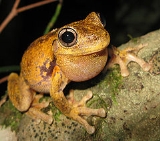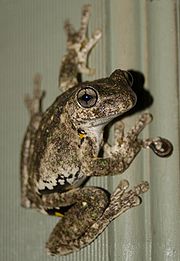
Peron's Tree Frog
Encyclopedia
Peron's Tree Frog, Emerald Spotted Tree Frog, Laughing Tree Frog or the Maniacal Cackle Frog (Litoria peronii) is a common Australian tree frog
of the genus Litoria
.
within the Litoria genus.
The male Peron tree frog is approximately 44-53 mm while Females are 46-65 mm.
 The call of Peron's Tree Frog, is a high pitched cackle, giving it the common names: the "Laughing Tree Frog" and the "Maniacal Cackle Frog". The frog is found in forests, woodlands, shrub-lands and open areas, often far away from a water source. They inhabit a variety of niches, predominantly in arboreal situations, such as tree hollows, cracks and beneath the flaking bark. The frog is commonly found near civilisation (such as suburban Sydney), using ponds or dams as their breeding water source. It can often be seen on windows or near lights at night, as it hunts the insects attracted to these light sources. They can often be found at dusk on houseboat windows and beneath street lamps along the Murray River in South Australia.
The call of Peron's Tree Frog, is a high pitched cackle, giving it the common names: the "Laughing Tree Frog" and the "Maniacal Cackle Frog". The frog is found in forests, woodlands, shrub-lands and open areas, often far away from a water source. They inhabit a variety of niches, predominantly in arboreal situations, such as tree hollows, cracks and beneath the flaking bark. The frog is commonly found near civilisation (such as suburban Sydney), using ponds or dams as their breeding water source. It can often be seen on windows or near lights at night, as it hunts the insects attracted to these light sources. They can often be found at dusk on houseboat windows and beneath street lamps along the Murray River in South Australia.
Tree frog
Hylidae is a wide-ranging family of frogs commonly referred to as "tree frogs and their allies". However, the hylids include a diversity of frog species, many of which do not live in trees, but are terrestrial or semi-aquatic.-Characteristics:...
of the genus Litoria
Litoria
Litoria is a genus of Hylidae tree frogs native to Australia, the Bismarck Archipelago, the Solomon Islands, New Guinea, the Lesser Sunda Islands, the Moluccan Islands, and Timor. They are sometimes collectively referred to as Australasian treefrogs...
.
Physical description
Peron's Tree Frog is one of the most varied coloured frogs in Australia, with the ability to change colour in less than one hour. It varies in shades of grey and brown, where its lightest is almost white. The frog has mottled yellow and black thighs, armpits and groin. Occasionally emerald spots are found on the back, which increase in number with age. A characteristic uncommon in the Litoria genus, is pupils which appear cross shaped. This characteristic is only shared with Tyler's Tree FrogTyler's Tree Frog
Tyler's Tree Frog or the Southern Laughing Tree Frog is an arboreal tree frog native to eastern Australia. It occurs from Southeast Queensland to the south coast of New South Wales...
within the Litoria genus.
The male Peron tree frog is approximately 44-53 mm while Females are 46-65 mm.
Ecology and behaviour


